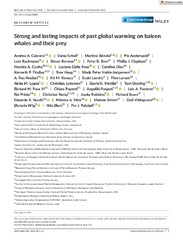Strong and lasting impacts of past global warming on baleen whales and their prey
Permanent lenke
https://hdl.handle.net/10037/24441Dato
2022-02-02Type
Journal articleTidsskriftartikkel
Peer reviewed
Forfatter
Cabrera, Andrea A.; Schall, Elena; Berube, Martine; Anderwald, Pia; Berrow, Simon; Best, Peter B.; Cunha, Haydée A.; Dalla Rosa, Luciano; Dias, Carolina P.; Findlay, Kenneth P.; Haug, Tore; Heide-Jørgensen, Mads-Peter; Hoelzel, A. Rus; Kovacs, Kit M.; Landry, Scott; Larsen, Finn; Moreira Lopes, Xenia; Lydersen, Christian; Mattila, David K.; Oosting, Tom; Pace III, Richard M.; Papetti, Chiara; Paspati, Angeliki; Pastene, Luis A.; Prieto, Rui; Ramp, Christian; Robbins, Jooke; Sears, Richard; Secchi, Eduardo; Silva, Monica A.; Simon, Malene; Vikingsson, Gísli A.; Wiig, Øystein; Palsbøll, Per J.; Øien, Nils; Bachmann, Lutz; Clapham, Phillip J.Sammendrag
Global warming is affecting the population dynamics and trophic interactions across
a wide range of ecosystems and habitats. Translating these real-time effects into their
long-term consequences remains a challenge. The rapid and extreme warming period
that occurred after the Last Glacial Maximum (LGM) during the Pleistocene–Holocene
transition (7–12 thousand years ago) provides an opportunity to gain insights into the
long-term responses of natural populations to periods with global warming. The effects of this post-LGM warming period have been assessed in many terrestrial taxa,
whereas insights into the impacts of rapid global warming on marine taxa remain limited, especially for megafauna. In order to understand how large-scale climate fluctuations during the post-LGM affected baleen whales and their prey, we conducted an
extensive, large-scale analysis of the long-term effects of the post-LGM warming on
abundance and inter-ocean connectivity in eight baleen whale and seven prey (fish
and invertebrates) species across the Southern and the North Atlantic Ocean; two
ocean basins that differ in key oceanographic features. The analysis was based upon
7032 mitochondrial DNA sequences as well as genome-wide DNA sequence variation
in 100 individuals. The estimated temporal changes in genetic diversity during the
last 30,000 years indicated that most baleen whale populations underwent post-LGM
expansions in both ocean basins. The increase in baleen whale abundance during the
Holocene was associated with simultaneous changes in their prey and climate. Highly
correlated, synchronized and exponential increases in abundance in both baleen
whales and their prey in the Southern Ocean were indicative of a dramatic increase
in ocean productivity. In contrast, the demographic fluctuations observed in baleen
whales and their prey in the North Atlantic Ocean were subtle, varying across taxa
and time. Perhaps most important was the observation that the ocean-wide expansions and decreases in abundance that were initiated by the post-LGM global warming, continued for millennia after global temperatures stabilized, reflecting persistent,
long-lasting impacts of global warming on marine fauna.
Forlag
WileySitering
Cabrera AA, Schall E, Berube M, Anderwald P, Bachmann L, Berrow S, Best, Clapham, Cunha HA, Dalla Rosa L, Dias CP, Findlay, Haug t, Heide-Jørgensen M, Hoelzel AR, Kovacs K, Landry S, Larsen F, Moreira Lopes, Lydersen C, Mattila, Oosting T, Pace III, Papetti, Paspati, Pastene LA, Prieto R, Ramp C, Robbins J, Sears R, Secchi E, Silva MA, Simon M, Vikingsson GA, Wiig Ø., Palsbøll PJ. Strong and lasting impacts of past global warming on baleen whales and their prey. Global Change Biology. 2021Metadata
Vis full innførselSamlinger
Copyright 2022 The Author(s)


 English
English norsk
norsk